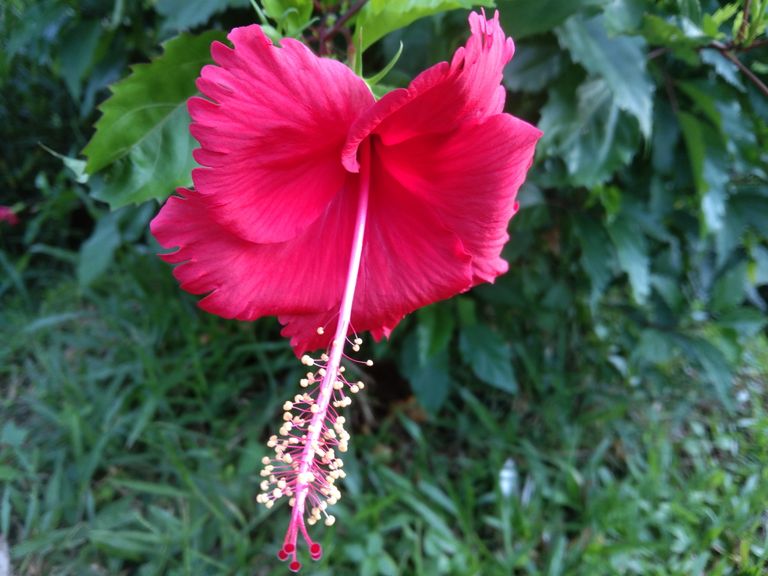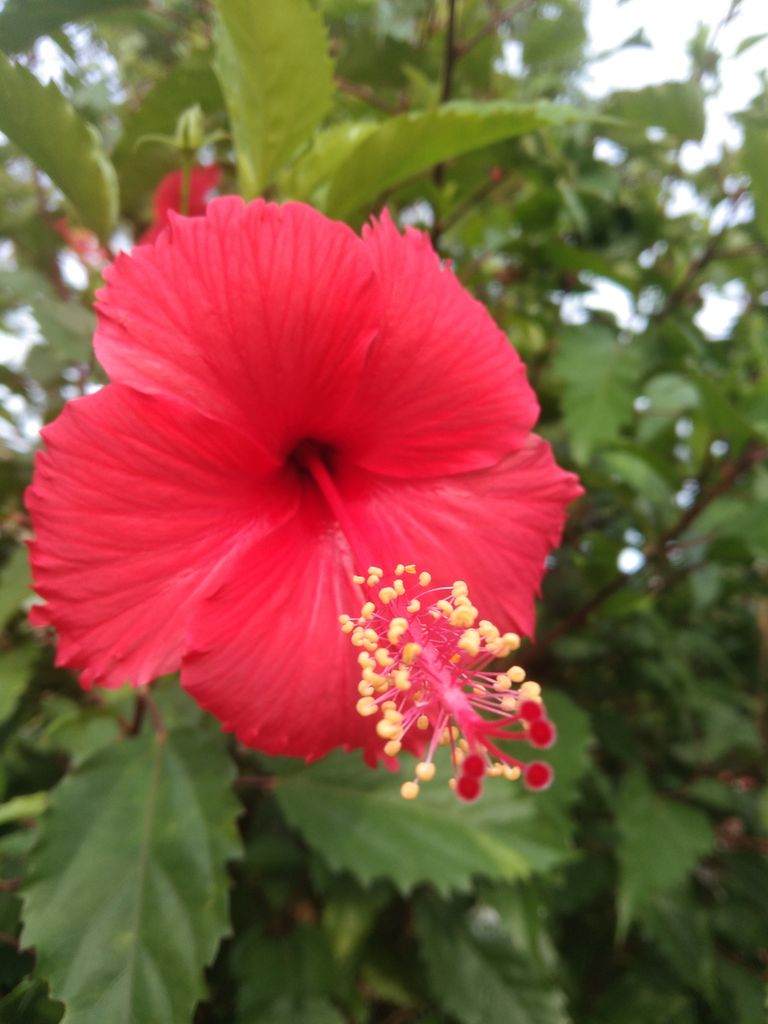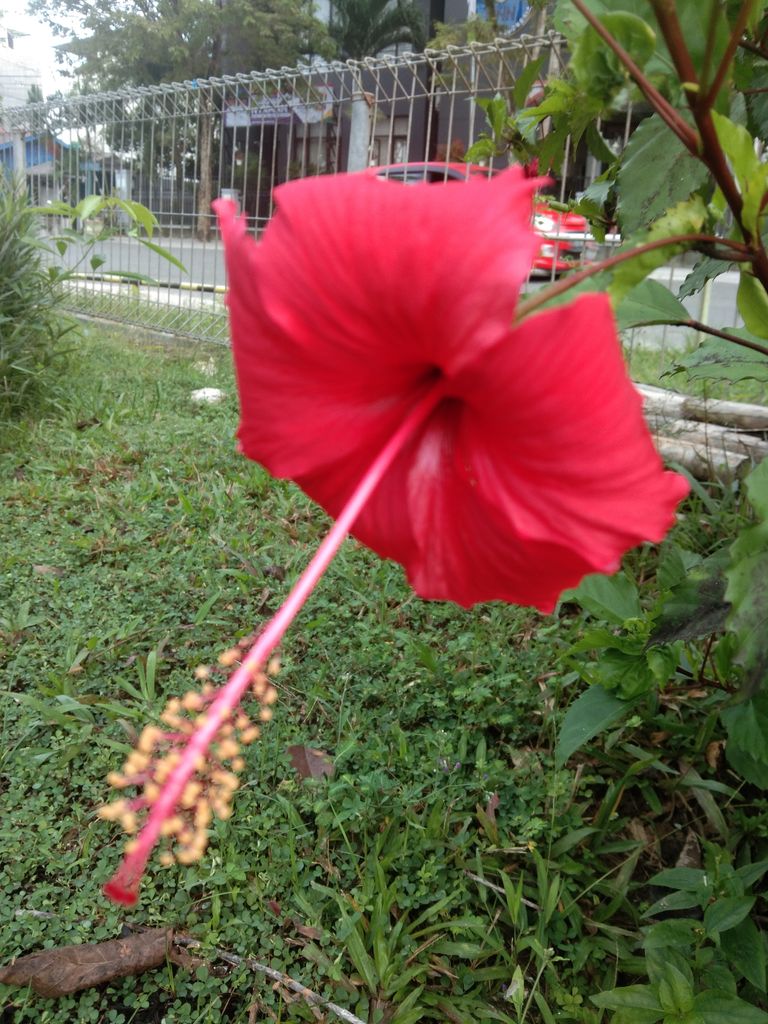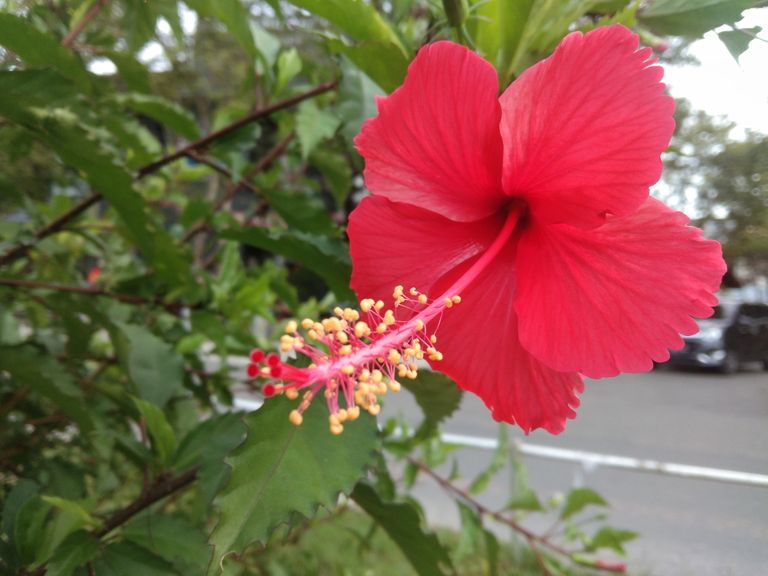Hello Blurtters,
Today I’m going to share you five photos of beautiful Hibiscus flowers that I took using the camera of a smartphone. Hope you like it.





Cheers,
Larasbpn

Kembang sepatu adalah tanaman semak suku Malvaceae yang berasal dari Asia Timur dan banyak ditanam sebagai tanaman hias di daerah tropis dan subtropis. Bunga besar, berwarna merah dan tidak berbau. Bunga dari berbagai kultivar dan hibrida bisa berupa bunga tunggal (daun mahkota selapis) atau bunga ganda (daun mahkota berlapis) yang berwarna putih hingga kuning, oranye hingga merah tua atau merah jambu.
Bunga jenis ini terdiri dari 5 helai daun kelopak, yang dilindungi oleh kelopak tambahan (epicalyx), sehingga terlihat seperti dua lapis kelopak bunga. Mahkota bunga terdiri dari 5 lembar atau lebih jika merupakan hibrida. Tangkai putik berbentuk silinder panjang dikelilingi tangkai sari berbentuk oval yang bertaburan serbuk sari. Biji terdapat di dalam buah berbentuk kapsul berbilik lima.
Pada umumnya tinggi tanaman sekitar 2 sampai 5 meter. Daun berbentuk bulat telur yang lebar atau bulat telur yang sempit dengan ujung daun yang meruncing. Di daerah tropis atau di rumah kaca tanaman berbunga sepanjang tahun, sedangkan di daerah subtropis berbunga mulai dari musim panas hingga musim gugur.
Bunga berbentuk trompet dengan diameter bunga sekitar 6 cm hingga 20 cm. Putik (pistillum) menjulur ke luar dari dasar bunga. Bunga bisa mekar menghadap ke atas, ke bawah, atau menghadap ke samping. Pada umumnya, tanaman bersifat steril dan tidak menghasilkan buah. Tanaman berkembang biak dengan cara stek, pencangkokan, dan penempelan.
Kembang sepatu banyak dijadikan tanaman hias karena bunganya yang cantik. Bunga digunakan untuk menyemir sepatu di India dan sebagai bunga persembahan. Di Tiongkok, bunga yang berwarna merah digunakan sebagai bahan pewarna makanan. Di Indonesia, daun dan bunga digunakan dalam berbagai pengobatan tradisional. Kembang sepatu yang dikeringkan juga diminum sebagai teh.
Di Okinawa, Jepang digunakan sebagai tanaman pagar. Di bagian selatan Okinawa, tanaman ini disebut Gushōnu hana (bunga kehidupan sesudah mati) sehingga banyak ditanam di makam.
[](https://id.wikipedia.org/wiki/
Agar tak salah langkah, begini cara menanam kembang sepatu dengan wadah pot:
- Ketahui Cuaca yang Tepat untuk Menanam
Tahukah Moms kalau bunga kembang sepatu bisa hidup hingga 40 tahun? Ya, tanaman ini adalah jenis tanaman semak yang bisa bertahan lama.
Meski demikian, anda perlu tahu bahwa bunga kembang sepatu tidak bisa hidup di daerah yang suhunya terlalu dingin.
Jadi, anda perlu memastikan bahwa daerah rumah anda memiliki suhu 15-32 derajat Celcius saja.
Jika di bawah suhu tersebut, bunga kembang sepatu tidak akan bisa tumbuh dengan subur.
- Siapkan Media Tanam
Nah, kita akan membahas cara menanam bunga kembang sepatu dalam pot.
Jadi, media tanam yang perlu disiapkan adalah wadah pot yang memiliki campuran tanah dan pupuk rendah fosfor dan tinggi kalium.
Kembang sepatu pada dasarnya adalah tanaman yang menyukai tanah asam.
Oleh karena itu, jika pH tanah terlalu basa, maka and bisa menambahkan tanah gambut yang berasal dari lumut.
Tanah tersebut bisa membuat tanaman menjadi lebih subur dan sehat.
- Cara Menanam Benih Kembang Sepatu
Langkah yang perlu diperhatikan berikutnya adalah, anda perlu melubangi media tanam sedalam 1-2 cm.
Coba masukkan benih kembang sepatu secara perlahan ke dalam lubang tersebut, lalu tutupi kembali dengan tanah secara tipis-tipis.
Nah, itu dia cara penanaman bunga kembang sepatu yang benar, anda.
Jangan sampai salah, karena bunga kembang sepatu tidak bisa tumbuh dengan subur apabila media tanamnya tidak tepat atau tanahnya tidak sesuai.
Hibiscus rosa-sinensis is a bushy, evergreen shrub or small tree growing 2.5–5 m (8–16 ft) tall and 1.5–3 m (5–10 ft) wide, with glossy leaves and solitary (axillary), symmetrical, typically red flowers in summer and autumn. The five-petaled flowers are 10 cm (4 in) in diameter, with prominent orange-tipped red anthers.[6] Cultivars and hybrids have flowers in a variety of colors as well as red: white, pink, orange, peach, yellow, blue, and purple. Some plants have double flowers.
At the bottom of every hibiscus bud is the calyx, which is green in color. The pointed ends of the calyx are called the sepals. When the hibiscus begins to bloom, the flower's petals begin to grow.
Each hibiscus flower has both male and female parts. The ovary and other female parts of the flower lie in the main structure of the hibiscus: the pistil, which is long and tubular. The five "hairy" spots at the top of the pistil make up the stigma, which is where pollen is collected. In the middle of the pistil is the style, which is the tube down which pollen travels to the ovary. The ovary lies at the bottom of the blossom, and each hibiscus has only one superior ovary. The male part of the flower, called the stamen, consists of stem-like filaments and anthers. Each filament ends with the pollen-producing anther.
The hibiscus plant has a branched taproot. The plant's stem is aerial, erect, green, cylindrical, and branched. The leaf is simple and petiolate, with alternate phyllotaxy. The leaf shape is ovate, the tip is acute, and the margin is serrated. Venation is unicostate reticulate, meaning the leaves' veins are branched or divergent. Free lateral stipules are present.
The flowers of Hibiscus rosa-sinensis are edible and are used in salads in the Pacific Islands. The flower is used as an accessory, particularly as a hairpiece. It is also used to shine shoes in certain parts of India, hence the common name "shoeblack plant." In Indonesia, these flowers are called "kembang sepatu", which literally means "shoe flower". The flower can also be used as a pH indicator; when used, the flower turns acidic solutions to a dark pink or magenta color and turns basic solutions to green. Red hibiscus flowers are also used for worship; in Hinduism, they are used for the worship of Devi, and in the Bengal area of eastern India, they are used to worship Kali. The hibiscus also has an important part in tantra. In several countries the flowers are dried to use in a beverage, usually tea.
Hibiscus rosa-sinensis is considered to have a number of medical uses in Chinese herbology. Traditional uses in China have been to make a black shoe-polish from its flower petals, or to make a woman's black hair dye. The flowers are also used in parts of China to color various intoxicating liquors. The plant may have some potential in cosmetic skin care; for example, an extract from the flowers of Hibiscus rosa-sinensis has been shown to function as an anti-solar agent by absorbing ultraviolet radiation.
Hibiscus rosa-sinensis is the national flower of Malaysia, called bunga raya in Malay. This can be translated in a number of ways, including "great flower" or "celebratory flower." Introduced into the Malay Peninsula in the 12th century, it was nominated as the national flower in the year 1958 by the Ministry of Agriculture amongst a few other flowers, namely ylang ylang, jasmine, lotus, rose, magnolia, and medlar. On July 28, 1960, it was declared by the government of Malaysia that Hibiscus rosa-sinensis would be the national flower. The red of the petals symbolizes the courage, life, and rapid growth of the Malaysian people, and the five petals represent the five Rukun Negara of Malaysia. The flower can be found imprinted on the notes and coins of the Malaysian ringgit.
Hibiscus rosa-sinensis is an unofficial national flower in Haiti, where it has been used as a symbol for the promotion of tourism. The flower is also the symbol of the Fusion of Haitian Social Democrats political party. It is known in Haitian Creole language as choeblack or rose kayenn.
The yellow variety of the hibiscus is the official flower of Hawaiʻi, where it is often hybridized and is worn ornamentally in the hair and in lei. In Hawaiian, hibiscus is called aloalo.
** Your post has been upvoted (19.85 %) **
Curation Trail is Open!
Join Trail Here
Delegate more BP for bigger Upvote + Daily BLURT 😉
Delegate BP Here
Upvote
https://blurtblock.herokuapp.com/blurt/upvote
Thank you 🙂 @tomoyan